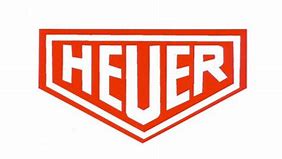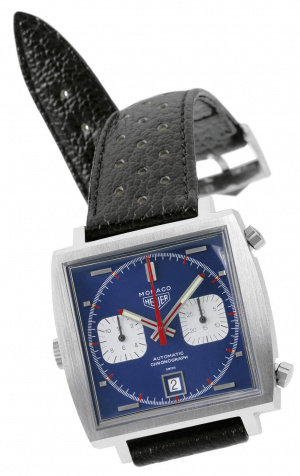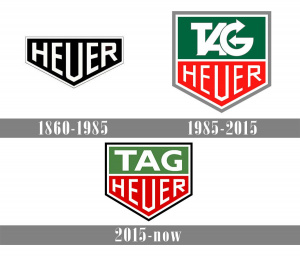Heuer

Heuer and TAG Heuer
The company began as Uhrenmanufaktur Heuer AG, founded in 1860 by Edouard Heuer in St-Imier, Switzerland. In 1985, TAG Group purchased a majority stake in the company, forming TAG Heuer. In 1999, French luxury goods conglomerate LVMH bought nearly 100 percent of the Swiss company. The name TAG Heuer combines the initials of "Techniques d'Avant Garde" and the founder's surname.
TAG Heuer is based in La Chaux-de-Fonds, Switzerland, and is led by CEO Frédéric Arnault. Jack Heuer, the great-grandson of the founder, is the honorary chairman. TAG Heuer maintains a watchmaking workshop in Cornol, Switzerland, and a watchmaking factory in La Chaux-de-Fonds. The TAG Heuer slogan is "Swiss Avant-Garde Since 1860".
History
1860 through 1880s
The company traces its roots to 1860, when Edouard Heuer founded Uhrenmanufaktur Heuer AG (English: Heuer Watchmaking Inc.) in St-Imier, Switzerland. Edouard Heuer patented his first chronograph in 1882 and in 1887 patented an "oscillating pinion" still used by major watchmakers of mechanical chronographs.
1910s
In 1911, Heuer received a patent for the "Time of Trip", the first dashboard chronograph. Designed for use in automobiles and aircraft, two large hands mounted from the center pinion indicate the time of day, as on a traditional clock. A small pair of hands, mounted at the top of the dial (12 o'clock position) indicates the duration of the trip (up to 12 hours). A top-mounted crown allows the user to set the time; a button mounted in that crown operates the start/stop/reset functions of the "duration of trip" counter. Heuer introduced its first wrist chronograph in 1914. The crown was at the 12 o'clock position, as these first wrist chronographs were adapted from pocket chronographs. In 1916 Edward Heuer's son, Charles-Auguste introduced the "Mikrograph", the first stopwatch accurate to 1/100 of a second. This model was soon followed by the "Semikrograph", a stopwatch that offered 1/50 of a second timing, as well as a split-second function (which allows the user to determine the interval between two contestants or events).
1930s and 1940s
In 1933, Heuer introduced the "Autavia", a dashboard timer used for automobiles and aviation (whence its name, from "AUTos" and "AVIAtion"). The companion "Hervue" was a clock that could run for eight days without being wound. Over the period from 1935 through the early 1940s, Heuer manufactured chronographs for pilots in the Luftwaffe, known as "Flieger" (pilot) chronographs. The earlier version featured a hinged-back case and one pusher (for start/stop/reset); the later version had a snap-back case and added a second pusher (for time-in and time-out). All these Flieger chronographs had two-registers, with a capacity of 30 minutes." In the mid-1940s, Heuer expanded its line of chronographs to include both two- and three-register models, as well as a three-register chronograph that included a full calendar function (day/date/month). As the highest development of Heuer's chronographs, these "triple calendar" chronographs were offered in stainless steel, 14 karat gold and 18K and 22K gold cases. Dial colors were white, black or copper.
1950s
In the early-1950s, Heuer produced watches for the American retailer Abercrombie & Fitch. The "Seafarer" and "Auto-Graph" were chronographs produced by Heuer to be sold by Abercrombie & Fitch. The "Seafarers" had special dials—with blue, green and yellow patterns—that showed the high and low tides. This dial could also be used to track the phases of the moon. Heuer produced a version of the "Seafarer" for sale under the Heuer name, with this model called the "Mareographe". The "Auto-Graph" was produced in 1953 and 1954, and featured a tachymeter scale on the dial and a hand that could be preset to a specific point on the scale. This allowed a rally driver or navigator to determine whether the car was achieving the desired pace, over a measured mile. Advertisements and literature also pointed out that this hand could be rotated to count golf scores or other events.
Auto dashboard timers
From 1911, Heuer manufactured timepieces to be mounted on the dashboards of automobiles, aircraft, and boats. These clocks and timers included a variety of models, designed to address specific needs of racers and rallyists. In 1958, Heuer introduced a new line of dashboard timepieces, which included the Master Time (8-day clock), the Monte Carlo (12-hour stopwatch), the Super Autavia (full chronograph), Sebring (60-minute, split-second timer), and Auto-Rallye (60-minute stopwatch). Heuer continued to manufacture these dashboard timepieces into the 1980s, at which time they were discontinued. Heuer also introduced timing devices for ski and motor racing events, including Formula One.
1960s
From the 1950s to the 1970s, Heuers were popular watches among automobile racers, both professionals and amateurs.[7] Heuer was a leading producer of stopwatches and timing equipment, based on the volume of its sales, so it was only natural that racers, their crews and event sponsors began to wear Heuer chronographs. Special versions of Heuer chronographs were produced with logos of the Indianapolis Motor Speedway, as well as the names or logos of racing teams or sponsors (for example, Shelby Cobra, MG and Champion Sparkplugs). In 1962, Heuer became the first Swiss watchmaker in space. John Glenn wore a Heuer stopwatch when he piloted the Mercury Atlas 6 spacecraft on the first US manned space flight to orbit the earth.[9] This stopwatch was the back-up clock for the mission and was started manually by Glenn 20 seconds into the flight. It is currently on display at the San Diego Air and Space Museum. The Autavia chronograph was introduced in 1962 and featured a rotating bezel, marked in either hours, minutes, decimal minutes (1/100th minute increments), or with a tachymeter scale. All manual-wind Autavias from the 1960s had a black dial, with white registers. Early cases had a screw-back and later models (from and after 1968) had snap-backs. The "Autavia" name had previously been used on Heuer's dashboard timers (described above). 1963 The Carrera chronograph was introduced, designed by Jack Heuer, great-grandson of Edouard. The Carrera had a very simple design, with only the registers and applied markers on the dial. The fixed inner bezel is divided into 1/5 second increments. The 1960s Carreras were available with a variety of dials, including all-white, all-black, white registers on a black dial, and black registers on a black dial. A three-register, triple calendar version of the Carrera was introduced around 1968.

Most of Heuer chronographs from this period—including the Autavias and Carreras—used movements manufactured by Valjoux, including the Valjoux 72 movement (for a 12-hour chronograph) and the Valjoux 92 movement (for a 30-minute or 45-minute chronograph). The Valjoux 72 movement utilized a "tri-compax" design, with three registers on the dial—one register for the chronograph hours (at the bottom), one register for the chronograph minutes (at the right), and a third register for a continuously running second hand (at the left). The second hand for the chronograph was mounted on the center pinion, along with the time-of-day hands. Heuer acquired the "Leonidas" brand in the early-1960s, with the combined company marketing watches under the "Heuer-Leonidas" name. One of the designs that Heuer acquired from Leonidas was the "Bundeswehr" chronograph, used by the German air force. These "BWs" feature a "fly-back" mechanism, so that when the chronograph is reset to zero, it immediately begins running again, to time the next segment or event. Automatic chronographs In the mid-1960s, Heuer partnered with Breitling and Hamilton (and in competition with Seiko and Zenith) to introduce an automatic chronograph. These projects were conducted in secret, as none of the competitors wanted the other companies to be aware of their efforts. Heuer-Breitling-Hamilton held press conferences in Geneva and New York, on 3 March 1969 to show their new lines of chronographs. Heuer's first automatic chronographs were the Autavia, Carrera, and Monaco. These were powered by the Cal 11 and Cal 12 movements (12-hour chronograph); Cal 14 movement (12-hour chronograph and additional hand for GMT/second time-zone) and the Cal 15 movement (30-minute chronograph). The winding crown was on the left, with the pushers for the chronograph on the right. The earliest of Heuer's Cal 11 chronographs (from 1969) were named "Chrono-Matic". In the early-1970s, Heuer expanded its line of automatic chronographs to include the Daytona, Montreal, Silverstone, Calculator, Monza, and Jarama models, all powered by the Calibre 11 movement.
1970s
In 1975, Heuer introduced the Chronosplit, a digital chronograph with dual LED and LCD displays. Later versions featured two LCD displays. Heuer began using the Valjoux 7750 movement in its automatic chronographs, with the Kentucky and Pasadena models (both introduced in 1977). The Valjoux 7750 movement was a three-register chronograph (with seconds, minutes, and hours), that also offered day/date windows. In the mid-1970s, Heuer introduced a series of chronographs powered by the Lemania 5100 movement. The Lemania 5100 movements have the minute hand for the chronograph on the center pinion (rather than on a smaller register), greatly improving legibility. The Lemania 5100 movement is considered very rugged and has been used in a variety of chronographs issued to military pilots. There are ten models of Heuer chronographs powered by the Lemania 5100—Reference 510.500 (stainless steel), 510.501 (black coated), 510.502 (olive drab coated), 510.503 (pewter-coated), 510.511 (Carrera dialed acrylic crystal PVD finish), 510.523 (Carrera dialed acrylic crystal stainless steel), as well as models with the names Silverstone (steel case with black dial) and Cortina (steel case with blue dial); the Reference 510.543 was made for the A.M.I. (Italian Air Force) and a special edition (with no reference number marked on the case) was made for AudiSport.

1980–present
TAG Heuer formed in 1985 when TAG (Techniques d'Avant Garde), manufacturers of high-tech items such as ceramic turbochargers for Formula One cars, and British businessman Ron Dennis, acquired Heuer. In 1999 TAG Heuer accepted a bid from LVMH Moët Hennessy Louis Vuitton S.A. of CHF 1.15 billion (£452.15 million, USD 739 million), contingent upon a transfer of 50.1 percent of stock.
Notable Models
- The Dalton Watches
- Heuer Monaco
- Heuer Pasadena
- Heuer Regatta
- Heuer Skipper
- Heuer Regate
- Heuer 2000 Chronograph
